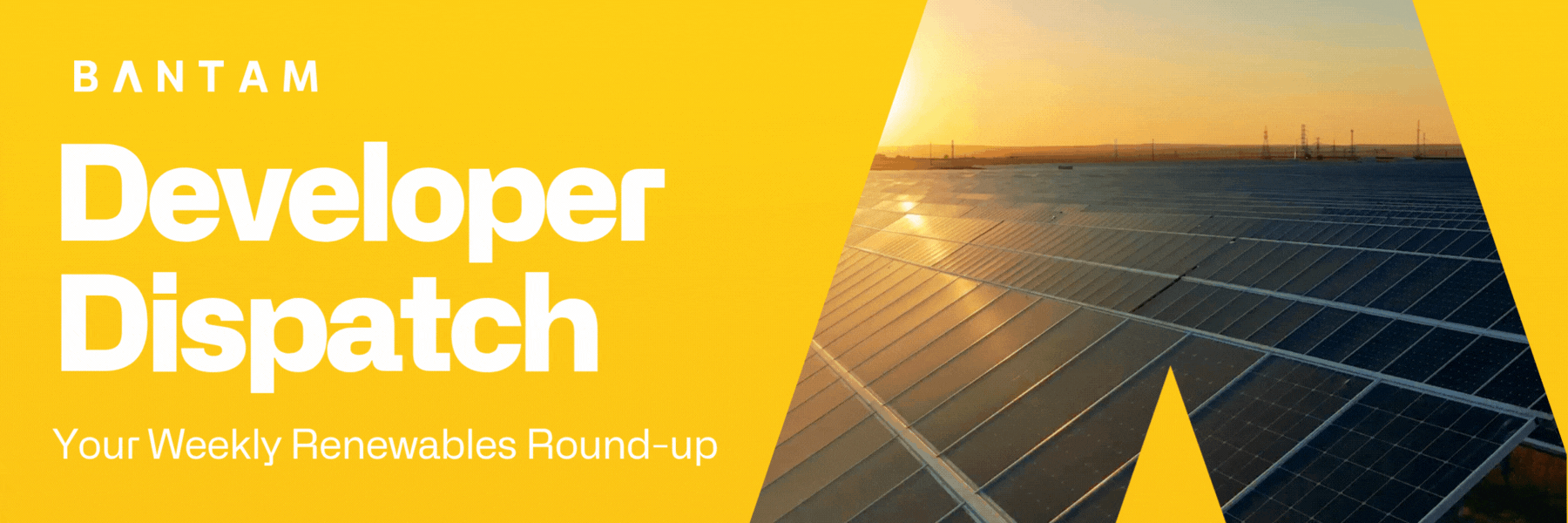|
|
 |
|
|
Good morning and happy Friday,
This week, the bipartisan House Problem Solvers Caucus released a sweeping permitting framework that revives familiar proposals to ease the federal process for massive infrastructure projects like pipelines and transmission lines. Although the framework signals possible progress on the issue, “it does not necessarily mean the deal will get enough buy-in to cross the finish line,” and no
legislation has been drafted.
And the battle over U.S. offshore wind continues. Last Friday, the Interior Department asked a judge to cancel approval of the Maryland Offshore Wind Project, a move developer U.S. Wind characterized as “politically motivated.”
Meanwhile, Rhode Island and Connecticut have requested an injunction against the Revolution Wind stop-work order, and a new anti-offshore wind group has formed to “protect the ocean,” but in California, offshore wind (at least the floating kind) has been propped up by Prop 4, which allocates $228 million for port upgrades.
And in Indiana, the state’s top energy official blasted what she called “disgraceful” county-level restrictions on wind and solar projects. With 72 of the state’s 92 counties imposing some form of ban or limit, she warned that the patchwork approach is driving away investment and undermining Indiana’s business agenda.
Read on for more.
|
|
|
 |
|
|
Turning NIMBYs Into YIMBYs
A recent article in The Guardian takes a deep dive into how misinformation, fear, and politics caused Walworth County, SD, to “drive away millions” in revenue from a potential solar farm. Although the county is facing significant economic challenges that the project could have helped address, local opposition groups spread wildly exaggerated claims of potential harms, “many of which found fertile ground in the anxieties of Walworth’s residents.” Here’s a closer look:
Concerns included the loss of farmland and the aesthetic impact of the project, which would have used around 3,200 acres of the 452,800 acres in the county. The landowner that hoped to host the project on half of his property believed it was a “better use of the land,” particularly given the uncertainty of agricultural markets.
Opponents of the project cited debunked claims about solar panel toxicity, EMF radiation, and impacts to local weather patterns, including the mistaken belief that the panels could affect rainfall patterns or “bring in hail storms.”
Ultimately, Walworth County passed a strict ordinance requiring solar projects to be one mile from dwellings, effectively blocking the solar project and any future large-scale solar initiatives.
⚡️ The Takeaway
YIMBYs fight back. Community engagement can make the difference between projects getting built or getting blocked. Walworth County is a cautionary tale, but in Santa Fe, a YIMBY coalition is pushing back against falsehoods and winning support for solar. The Clean Air Task Force’s latest report makes it plain: sustained engagement is the key to delivering clean energy. As farm bankruptcies rise and rural economies face mounting pressure, the real test will be whether facts and partnerships can outpace fear.
|
|
|
 |
|
|
Americans Want a Stronger Grid
Headlines about rising electricity bills abound, and voters are making the connection: power prices, clean energy, and transmission lines are linked. A new survey by the Conservative Energy Network shows strong public support for expanding the grid to boost affordability and reliability. Here’s the buzz:
In addition to Missouri and Arkansas, the survey included respondents in Pennsylvania and Ohio — both stuck in PJM’s backlogged queue. Nearly 90% of voters said they were worried about rising energy costs.
Overall, three-fourths of likely voters support expanding the electric grid, and two-thirds favor more transmission lines to connect clean energy and strengthen reliability.
A second survey, released by WSP at the RE+ conference, found that 83% of Americans are concerned about affordability, and 65% would accept modestly
higher bills if it meant a more reliable grid.
⚡️ The Takeaway
An uphill slog. The Conservative Energy Network survey – which may be the first of its kind in terms of the specific issues it explored – may be something CEN can use to “convince decision makers to take steps to expand the grid.” It also tested messaging, finding (unsurprisingly) that it’s not a one-size-fits-all situation. However, “ultimately, affordability and reliability were the clear consensus energy policy priorities.” The challenge now is translating that voter mandate into federal action on transmission and clean energy buildout.
|
|
|
 |
|
|
Video: Economic fallout mounts as Trump halts wind power project
SPEED Demons: As Congress takes a new swing at bipartisan permitting reform, environmental groups are calling foul but Bipartisan NEPA reform
proposal gets electric utilities’ support
Wrong Problem: Wind turbines aren’t the biggest threat to birds
Follow the Money: The energy sector has spent hundreds of millions of dollars on lobbying this year. Watchdogs say that’s only half the story.
Fraying Fabric? California may help solar bloom where water runs dry
Ouch: U.S. solar trade barriers take their toll
OBBBA Overview: New risks for U.S. solar
Baseload Solar: ‘Power even without the sun’: first ‘baseload solar’ power plant achieves COD in Philippines
“Cheap, Fast, Simple, Secure:” Oil giant Saudi Arabia is emerging as a solar power
Disproportionate: Hail damage to solar projects: 1% of filed claims, but over 50% of total losses
War of Attrition: IRA repeal is empowering anti-renewables activists
“A Long Way to Go:” Iowa utilities must ‘rapidly’ make use of Biden-era renewable credits to reach emissions goals
Better Late Than Never: Can the nation’s most wind-powered state look to solar?
Transitioning From Coal: Illinois’ push to train workers for solar industry jobs is paying off
Pain → Gain: US solar sector sees rays of hope from the surge in data center, power demand
Economic Tailwinds: The solar industry threw a party in Vegas, and it actually wasn’t sad.
First of Its Kind: Explosion test ‘demonstrates effectiveness’ of BESS safety control system, Wärtsilä says
BESSame Mucho: Can BESS answer US data center power demand?
Tweaking: Riding the high from data centers, the grid cannot kick its gas habit
Debate Heats Up: As data centers go up, North Carolina weighs how to handle energy demand
Tough Love: US electric grids under pressure from energy-hungry data centers are changing strategy and PJM tries to ease threats to grid
from supersize data centers
Upside: AI is going to consume a lot of energy. It can also help us consume less.
Milestone: Regional Western electricity market closer to reality following California vote
Bridging the Gap: Department of Energy allocates $134 million for fusion funding
Gutting 45Q: The EPA moves to hobble the carbon capture industry and CCS financial risks climb as EPA cuts emissions
program
Polls: Do Americans Blame Trump or Biden for rising electricity prices? and Only 44% of
Americans would welcome a data center nearby
Robust Growth Ahead: Clean’ hydrogen to surge despite Trump’s megalaw, analysts say
|
|
|
 |
|
|
|
|
 |
|
|
HALEU on Wheels
Nuclear waste has long been a stumbling block for the U.S. nuclear industry. Unlike other countries such as France, which has developed a robust system for reprocessing spent fuel, the U.S. hasn’t embraced reprocessing, largely out of concerns that the resulting materials could be enriched to weapons-grade levels.
Two companies are hoping to change that, and to address the shortage of domestic fuel production many see as a significant obstacle for the nuclear power industry. If successful, their efforts will help develop a domestic supply chain for advanced reactors.
Curio, a tech startup, just announced major progress on its NuCycle recycling process with help from national labs. They’re working on turning nuclear waste into “enrichment-ready” uranium – referred to as high-assay, low-enriched uranium, or HALEU – that could power next-gen reactors.
|
|
 |
|
|
This could be a game-changer for advanced reactors in the U.S., because they often use HALEU as feedstock, but commercial scale production of HALEU only occurs in Russia and China. Meanwhile, Oklo, an advanced reactor designer, is diving in with a bold $1.6 billion plan to build a fuel recycling facility by the 2030s.
It’s important to remember that “history counsels humility in the nuclear reprocessing field,” but if the stars align in terms of policy, financing, and safety, these developments could help usher in a new era of nuclear energy in the U.S.
|
|
|
|
|
Thanks for diving into the Developer Dispatch with us.
|
|
|
|
|
|
|
|
|
|
Building American power requires a powerful team.
|
|
|
|
|
|
|
|
|